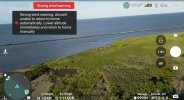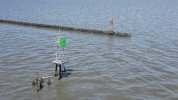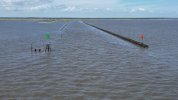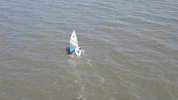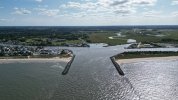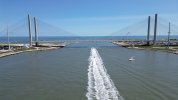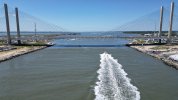You are using an out of date browser. It may not display this or other websites correctly.
You should upgrade or use an alternative browser.
You should upgrade or use an alternative browser.
Has anyone flown in 30-40 mph+ winds with M4P?
- Thread starter InAz
- Start date
I've flown the Mini 4 Pro in 17mph and it was NOT a good experience. Due to it's lightweight, very small changes in wind speed or direction had a significant effect on the aircraft it self. Ironically, the gimbal did an AMAZING job in making the movement almost undetectable view POV.
Since the aircraft specs state up to 24mph, you're risking it trying to go beyond their specs but . . . in S mode the Max Speed is stated at 16 m/s (35.7mph) you should be ok up to around 25-30 but note you're outside of the Design Specs and 100% all on you and your skills to keep in undented LOL.
Since the aircraft specs state up to 24mph, you're risking it trying to go beyond their specs but . . . in S mode the Max Speed is stated at 16 m/s (35.7mph) you should be ok up to around 25-30 but note you're outside of the Design Specs and 100% all on you and your skills to keep in undented LOL.
- Joined
- Feb 8, 2018
- Messages
- 8,536
- Reactions
- 13,800
- Age
- 56
We fly in some extreme winds with all the drones and when it comes to the Mini 3 Pro and Mini 4 Pro there both not a good choice as your likely to overheat the drone an make it force land. If it was not for the drone to be so quick to over heat , you might be able to push it a little bit . My advice is 20 mph an no more.
Last edited:
Was just curious to see what it'll due.We fly in some extreme winds with all the drones and when it comes to the Mini 3 Pro and Mini 4 Pro there both not a good choice as your likely to overheat the drone an make it force land. If it was not for the drone to be so quick to over heat , you might be able to push it a little bit . My advice is 20 mph winds
I won't risk damage by flying it beyond its limitations But know some do it.
Nobody knows what the DJI stated "wind resistance" is...
In the end... all that matters is the max heading speed the drone can achieve... max in Sport is 35,7mph, facing a equal fast headwind will result in that your drone just stands still fully tilted giving it all it has. If the head wind becomes larger than the max drone speed, the drone will start to drift backwards.
Besides the above, how it ends in a real flight... depends on many, many factors.
In the end... all that matters is the max heading speed the drone can achieve... max in Sport is 35,7mph, facing a equal fast headwind will result in that your drone just stands still fully tilted giving it all it has. If the head wind becomes larger than the max drone speed, the drone will start to drift backwards.
Besides the above, how it ends in a real flight... depends on many, many factors.
Something to consider for any replies is that very few flyers know what the actual wind speed is when they fly and many have no ability to estimate it correctly.I'm curious, has anyone tried to test the limits on the M4P above 30 mph?
It's a mistake to assume that the number DJI gives as their Max Wind Resistance is the maximum wind speed that the drone can handle.Specs show, I think, up to 24 mph but wonder if it's able to handle such winds.
What it really is, is a mystery as DJI never defined it and comparing the numbers they give for different drones, doesn't show any consistent pattern to help understand what DJI might mean.
I've frequently flown my Mavic 3 pro in winds up to 50% higher than what DJI shows for their Max Wind Resistance for that model.
Octisurfer
Active Member
However, I suspect that with more wind the aircraft usually gets more cooling. Is it possible that their aircraft heats up more when they are wrapped in the wet suit?We fly in some extreme winds with all the drones and when it comes to the Mini 3 Pro and Mini 4 Pro there both not a good choice as your likely to overheat the drone an make it force land. If it was not for the drone to be so quick to over heat , you might be able to push it a little bit . My advice is 20 mph an no more.
- Joined
- Feb 8, 2018
- Messages
- 8,536
- Reactions
- 13,800
- Age
- 56
No, the tests are done without the wet suit , pushing the motors with any weight on the drone can make it over heat quickly and thus to force land this is why we do not make the Rescue Jacket for the Mini 4 Pro.However, I suspect that with more wind the aircraft usually gets more cooling. Is it possible that their aircraft heats up more when they are wrapped in the wet suit?
Phantomrain.org
Gear to fly in the Rain. Land on the water.
Droning on and on...
Well-Known Member
Since the aircraft specs state up to 24mph, you're risking it trying to go beyond their specs but . . . in S mode the Max Speed is stated at 16 m/s (35.7mph) you should be ok up to around 25-30 but note you're outside of the Design Specs and 100% all on you and your skills to keep in undented LOL.
I've experimentally confirmed on the Mini3P the following, and I strongly suspect this is generally true for all recent models, perhaps as far back as the original Mavic:
- The Flight Controller in the aircraft controls for groundspeed as determined by GPS, not airspeed. This makes logical sense, as this is the only speed the drone can detect, lacking a pitot tube or other airspeed sensor.
- Up to some moderate headwind, the Mini3P was able to achieve and hold max Sport Mode speed. From memory I think this was around 8mph. This means it was flying faster through the air doing about 43mph, holding 35mph over the surface below. Therefore, there is some tilt "headroom" beyond the still-air angle necessary to achieve max speeds in the specs.
- In N mode it was able to hold groundspeed at 21mph in winds up to 12mph. Should be able to handle more.
- The pitch stick does not control pitch or tilt directly. Rather, it is a speed control that gives a ground speed demand to the drone, which the FC attempts to deliver by controlling roll/pitch to whatever angle necessary to achieve the commanded speed. Within design and operational limits, of course.
Why would one fly in the rain?However, I suspect that with more wind the aircraft usually gets more cooling. Is it possible that their aircraft heats up more when they are wrapped in the wet suit?
Last edited:
Wreckhunter
Well-Known Member
That is what I would like to know,just makes no sense at all.Why would one fly in the rain?
Octisurfer
Active Member
I don't fly in the rain. It is phantomrain.org's business to propagate this:Why would one fly in the rain?

Mini 3 Pro Wet Suit | Phantom Rain
Desigend to Negotiate the Pouring Rain. The Wet Suit are geared to protect the Battery the Power Button and the Gimbal as well as the inside of the drone. The Mini 3 Wet Suit utilize a Tab System so you can have full Protection to the drone when flying in the Rain and be able to switch out...
 www.phantomrain.org
www.phantomrain.org
Here in Florida, winds can build in no time. On my maiden flight, winds were mild when I took off. But about 20 minutes later, I started getting high wind warnings. On the ground the wind was steady with some powerful gusts. On the route I was taking back home, the winds were crosswinds, not headwinds. It made it back ok, but was getting blown around pretty bad. It also took longer than normal to land because it kept getting blown around. I moved it over grass in case it got tipped over on touchdown. I know my M2P would have handled it much better.
BroomRider
Well-Known Member
Due to an overload of “bizzyness” in my life since the start of this year, I've yet to take my Mini 4 Pro up.
But, I suspect that the performance of the Mini 3 Pro is very much similar, & I can confirm that it can manage some fairly stiff winds.
It was last year that I hand-launched it (trying to avoid sand, etc.) from my local beach, to take some photos of an inlet with markers, looking inland from over the water.
The winds were forecast to be a mild breeze, & it was sunny, & I checked that from the beach location, not from my home ~6 miles (ca. 10 km) inland.
But as it's wont to do, ocean-front weather can be changeable, & while I was heading out, the winds started picking up, but as I got closer, it really started blowing — thankfully, toward inland.
Luckily, I had the screen record on, & decided that those photos were going to have to wait — I turned around & flew back, 1st away from the ocean-beach waterline, up high enough to clear any ocean front structures, & then ducked down behind them for the shelter of the wind shadow.
I made it back, & was impressed that it flew as well as it did, & managed to return under manual control without needing to make an emergency landing.
But, as I had hand-launched, so I also hand-caught, & with the wind now in full breezy-gusty mode, the Mini 3 Pro made a valiant & very active effort, darting around, trying to remain in 1 position.
After several attempts, with the low battery alarm beeping, I finally did manage to catch it safely.
3 recommendations when flying in high(er) winds:
1. Always take off & fly into them, so the return is likely easier, not having to fight against the wind so much, nor run out of battery in doing so, on the way back to the launch point.
2. If the flight is over water, always try to avoid flying with an offshore wind, that is, with the wind blowing away from the shore, & for similar reasons to #1.
3. Encountering headwinds on the return flight, try to lower the altitude — the higher the altitude, the higher the winds will tend & likely be.
Although I've yet to try it, the “home point” can be changed to 1 in a better location during flight.
However, in the heat of the moment, it requires a cool head to think about trying that, knowing that your bird is in trouble.
I'll never forget what my grandfather said to me when I was learning to row a boat as a young child: “Never travel farther from the shore, than you can swim. When setting out, always head up current (he lived on a river) so if you get tired or run into trouble, the current will be with you on the way back.”
Epilogue: I did finally get a few photos, but it was on another day with more gentle winds (again, blowing onshore!) & some others with mild onshore winds also.
But, I suspect that the performance of the Mini 3 Pro is very much similar, & I can confirm that it can manage some fairly stiff winds.
It was last year that I hand-launched it (trying to avoid sand, etc.) from my local beach, to take some photos of an inlet with markers, looking inland from over the water.
The winds were forecast to be a mild breeze, & it was sunny, & I checked that from the beach location, not from my home ~6 miles (ca. 10 km) inland.
But as it's wont to do, ocean-front weather can be changeable, & while I was heading out, the winds started picking up, but as I got closer, it really started blowing — thankfully, toward inland.
Luckily, I had the screen record on, & decided that those photos were going to have to wait — I turned around & flew back, 1st away from the ocean-beach waterline, up high enough to clear any ocean front structures, & then ducked down behind them for the shelter of the wind shadow.
I made it back, & was impressed that it flew as well as it did, & managed to return under manual control without needing to make an emergency landing.
But, as I had hand-launched, so I also hand-caught, & with the wind now in full breezy-gusty mode, the Mini 3 Pro made a valiant & very active effort, darting around, trying to remain in 1 position.
After several attempts, with the low battery alarm beeping, I finally did manage to catch it safely.
3 recommendations when flying in high(er) winds:
1. Always take off & fly into them, so the return is likely easier, not having to fight against the wind so much, nor run out of battery in doing so, on the way back to the launch point.
2. If the flight is over water, always try to avoid flying with an offshore wind, that is, with the wind blowing away from the shore, & for similar reasons to #1.
3. Encountering headwinds on the return flight, try to lower the altitude — the higher the altitude, the higher the winds will tend & likely be.
Although I've yet to try it, the “home point” can be changed to 1 in a better location during flight.
However, in the heat of the moment, it requires a cool head to think about trying that, knowing that your bird is in trouble.
I'll never forget what my grandfather said to me when I was learning to row a boat as a young child: “Never travel farther from the shore, than you can swim. When setting out, always head up current (he lived on a river) so if you get tired or run into trouble, the current will be with you on the way back.”
Epilogue: I did finally get a few photos, but it was on another day with more gentle winds (again, blowing onshore!) & some others with mild onshore winds also.
Attachments
Last edited:
Similar threads
- Replies
- 16
- Views
- 2K
- Replies
- 38
- Views
- 6K
- Replies
- 0
- Views
- 2K
- Replies
- 38
- Views
- 5K
DJI Drone Deals
New Threads
-
Possible to sell RC Pro 2 controller separately from drone it came with?
- Started by Robw_z
- Replies: 3
-
-
Would an outdoor WIFI 6 range extender interfere with DJI drone flights?
- Started by jmc667
- Replies: 2
-
-
Members online
Total: 2,521 (members: 11, guests: 2,510)




